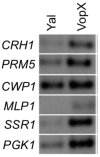Using S. cerevisiae as a Model System to Investigate V. cholerae VopX-Host Cell Protein Interactions and Phenotypes
- PMID: 26473925
- PMCID: PMC4626723
- DOI: 10.3390/toxins7104099
Using S. cerevisiae as a Model System to Investigate V. cholerae VopX-Host Cell Protein Interactions and Phenotypes
Abstract
Most pathogenic, non-O1/non-O139 serogroup Vibrio cholerae strains cause diarrheal disease in the absence of cholera toxin. Instead, many use Type 3 Secretion System (T3SS) mediated mechanisms to disrupt host cell homeostasis. We identified a T3SS effector protein, VopX, which is translocated into mammalian cells during in vitro co-culture. In a S. cerevisiae model system, we found that expression of VopX resulted in a severe growth defect that was partially suppressed by a deletion of RLM1, encoding the terminal transcriptional regulator of the Cell Wall Integrity MAP kinase (CWI) regulated pathway. Growth of yeast cells in the presence of sorbitol also suppressed the defect, supporting a role for VopX in destabilizing the cell wall. Expression of VopX activated expression of β-galactosidase from an RLM1-reponsive element reporter fusion, but failed to do so in cells lacking MAP kinases upstream of Rlm1. The results suggest that VopX inhibits cell growth by stimulating the CWI pathway through Rlm1. Rlm1 is an ortholog of mammalian MEF2 transcription factors that are proposed to regulate cell differentiation, proliferation, and apoptosis. The collective findings suggest that VopX contributes to disease by activating MAP kinase cascades that elicit changes in cellular transcriptional programs.
Keywords: S. cerevisiae CWI pathway; Type 3 Secretion System; VopX; cholera.
Figures






References
-
- Faruque S.M., Chowdhury N., Kamruzzaman M., Dziejman M., Rahman M.H., Sack D.A., Nair G.B., Mekalanos J.J. Genetic diversity and virulence potential of environmental Vibrio cholerae population in a cholera-endemic area. Proc. Natl. Acad. Sci. USA. 2004;101:2123–2128. doi: 10.1073/pnas.0308485100. - DOI - PMC - PubMed
-
- Singh D.V., Matte M.H., Matte G.R., Jiang S., Sabeena F., Shukla B.N., Sanyal S.C., Huq A., Colwell R.R. Molecular analysis of Vibrio cholerae O1, O139, non-O1, and non-O139 strains: Clonal relationships between clinical and environmental isolates. Appl. Environ. Microbiol. 2001;67:910–921. doi: 10.1128/AEM.67.2.910-921.2001. - DOI - PMC - PubMed
Publication types
MeSH terms
Substances
Grants and funding
LinkOut - more resources
Full Text Sources
Other Literature Sources

